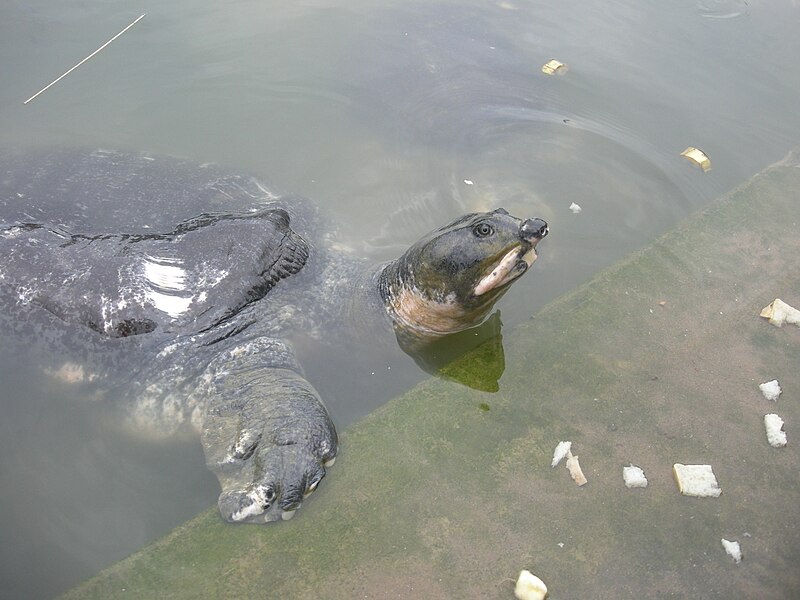The world’s 24 species of Softshell Turtles (Family Trionychidae) depart radically from the typical turtle body plan, and their behavior holds many surprises for those familiar with “normal” turtles. In Part 1 of this article we looked at their natural history and diet, and discussed the basics of captive care. I also relayed some of the difficulties inherent in working with these delicate creatures – difficulties that resulted in the loss of some huge and rare individuals of several species. I hope you enjoy the following Softshell observations and stories.
Rare US and Asian Softshells
 Swinhoe’s Softshell (Rafetus swinhoei, please see photo) may be the world’s rarest turtle; only 3 individuals are known to survive (reports of others are difficult to confirm). Two of the 3 are in zoos in China, but breeding efforts have been unsuccessful. The third, which has lived for decades in Hoan Kiem Lake in downtown Hanoi, Viet Nam, is a creature of legend (please see article below).
Swinhoe’s Softshell (Rafetus swinhoei, please see photo) may be the world’s rarest turtle; only 3 individuals are known to survive (reports of others are difficult to confirm). Two of the 3 are in zoos in China, but breeding efforts have been unsuccessful. The third, which has lived for decades in Hoan Kiem Lake in downtown Hanoi, Viet Nam, is a creature of legend (please see article below).
For decades, the huge Black Softshell or Botsami Turtle (Aspideretes nigricans, please see photo) was known only from a single population that inhabited a pond on the grounds of a shrine in India; the turtles have religious significance and may not be taken for study. Recently 1-2 additional groups have been found in Assam, India.
The Black Spiny Softshell (Apalone spinifera ater) is found only in Coahuila, Mexico’s Cuatro Cienegas Basin (home also to the better-known Coahuilan or Aquatic Box Turtle). Drainage canals have allowed the related Texas Spiny Softshell (A. s. emoryi) to invade the habitat. Hybridization between the 2 may doom the Black Spiny Softshell to extinction.
Softshells as Food – Personal Observations
Softshell Turtles of many species are consumed by people worldwide. Some years ago I launched a project to study Florida Softshells (Apalone ferox) in NYC food markets, and documented high levels of mercury…sadly, red tape intervened and my data is still sitting in a USDA file somewhere.
Today, farm-raised Chinese Softshells (Pelodiscus sinensis) are more in evidence in US food markets. Just recently I was dismayed to see that they are still being held under horrific conditions in some NYC markets (classified as “seafood” by the USDA, turtles can legally be stored in piles on ice, without regard to their well-being)…this is work I need to get back to.
Aggressive Giants
Reports surface sporadically of 6-foot-long turtles attacking boats; the usual suspect is Asia’s Narrow-Headed Softshell (Chitra indica). While the sud-adult Narrow Heads I’ve worked with proved among the most ill-tempered turtles imaginable, I’m not sure I buy the boat-attacking stories. They do get huge, though – at least 4 feet long and 300 pounds in weight, and possibly larger.
However, Softshells can be aggressive –I was surprised to see a captive male Nile Softshell (Trionyx triunguis) swim out and confront anyone who came near the large pool he inhabited; he paddled about with his neck raised high above the water, following intruders and trying to latch on to hands that strayed too close!

Marine Softshells?
The Nile Softshell, which sometimes exceeds 3 feet in length, usually inhabits large rivers. One population off Turkey, however, has adapted to life in the Mediterranean Sea! The Florida Softshell also sometimes occurs in brackish waters and estuaries, and is occasionally washed out into the ocean.
Further Reading
You can read more about the 3 remaining Swinhoe’s Softshell turtles here.
Video of unusual albino Softshells.
Bostami Softshell image referenced from wikipedia and originally posted by Rohan Uddin Fahad
Nile Softshell image referenced from wikipedia and originally posted by Nebulas2
 That Reptile Blog – Reptile, Amphibian and Exotic Pet Care and Information
That Reptile Blog – Reptile, Amphibian and Exotic Pet Care and Information


